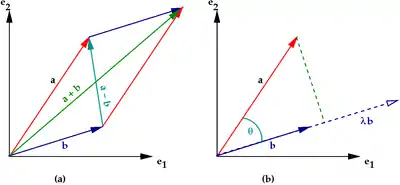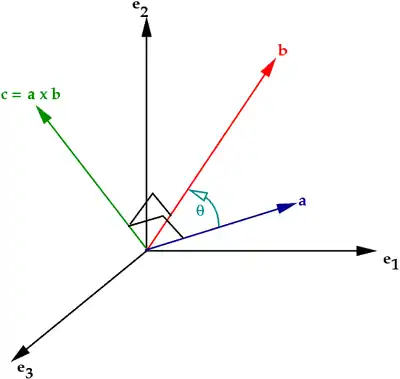Definitions of a vector
A vector is a mathematical concept that has both magnitude and direction. A vector is an object that has certain properties:
- a vector has a magnitude (or length) denoted as A
- a vector has a direction. denoted as a
A vector of length X pointing from left to right horizontally
A vector of length X pointing from left to right horizontally
A Vector sum of 2 vectors
From above, A vector of length X pointing from left to right horizontally
Vector Algebra Operations
 Figure 2: Vector operations.
Figure 2: Vector operations.
Addition and Subtraction
If and are vectors, then the sum is also a vector (see Figure 2(a)).
The two vectors can also be subtracted from one another to give another vector .
Multiplication by a scalar
Multiplication of a vector by a scalar has the effect of stretching or shrinking the vector (see Figure 2(b)).
You can form a unit vector that is parallel to by dividing by the length of the vector . Thus,
Scalar product of two vectors
The scalar product or inner product or dot product of two vectors is defined as
where is the angle between the two vectors (see Figure 2(b)).
If and are perpendicular to each other, and . Therefore, .
The dot product therefore has the geometric interpretation as the length of the projection of onto the unit vector when the two vectors are placed so that they start from the same point.
The scalar product leads to a scalar quantity and can also be written in component form (with respect to a given basis) as
If the vector is dimensional, the dot product is written as
Using the Einstein summation convention, we can also write the scalar product as
Also notice that the following also hold for the scalar product
- (commutative law).
- (distributive law).
Vector product of two vectors
The vector product (or cross product) of two vectors and is another vector defined as
where is the angle between and , and is a unit vector perpendicular to the plane containing and in the right-handed sense (see Figure 3 for a geometric interpretation)

In terms of the orthonormal basis , the cross product can be written in the form of a determinant
In index notation, the cross product can be written as
where is the Levi-Civita symbol (also called the permutation symbol, alternating tensor). This latter expression is easy to remember if you recognize that xyz, yzx, and zxy are "positive" and the others are negative: xzy, yxz, zyx.
If , then
Identities from Vector Algebra
Some useful vector identities are given below.
The rest of this resource has been moved to Vector calculus.
Coordination
Real Number Coordination
Scalar Value
Vector
Vector composites
Complex Number Coordination
Scalar Value
Vector
Vector composites
Complex Conjugate Number
Scalar Value
Vector
Vector composites
x,y,z an r vectors
Commonly in physics, we use position vectors to describe where something is in the space we are considering, or how its position is changing at that moment in time. Position vectors are written as summations of scalars multiplied by unit vectors. For example:

where x, y and z are scalars and and are unit vectors of the Cartesian (René Descartes) coordinate system. A unit vector is a special vector which has magnitude 1 and points along one of the coordinate frame's axes. Unit vectors for each direction can be written as either or . The figure to the left illustrates this with . A vector itself is typically indicated by either an arrow: , or just by boldface type: v, so the vector above as a complete equation would be denoted as:
This velocity vector follows the convention that subscripts denote the components of the velocity vector. Writing the components of as would be more consistent but is almost never done.
You can find the magnitude of a vector with this formula . For example, in two-dimensional space, this equation reduces to:
.
For three-dimensional space, this equation becomes:
.
Exercises
Find the magnitude of the following vectors.
|
|
|
|
|
|
Many problems, particularly in mechanics, involve the use of two- or three-dimensional space to describe where objects are and what they are doing. Vectors can be used to condense this information into a precise and easily understandable form that is easy to manipulate with mathematics.
Position - or where something is, can be shown using a position vector. Position vectors measure how far something is from the origin of the reference frame and in what direction, and are usually, though not always, given the symbol . It is usually good practice to use for position vectors when describing your solution to a problem as most physicists use this notation.
Velocity is defined as the rate of change of position with respect to time. You may be used to writing velocity, v, as a scalar because it was assumed in your solution that v referred to speed in the direction of travel. However, if we take the strict definition and apply it to the position vector, which is usually written:
Taking the time derivative:
We did not take the derivatives of the unit vectors because they are not changing. If the unit vectors are rotating, it is possible to take (vector) derivatives of them and derive the Coriolis force[1]